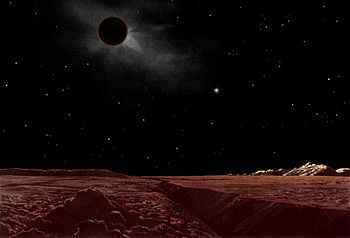This article has multiple issues. Please help improve it or discuss these issues on the talk page. (Learn how and when to remove these messages)
|


Solar eclipses on the Moon are caused when the planet Earth passes in front of the Sun and blocks its light. Viewers on Earth experience a lunar eclipse during a solar eclipse on the Moon.
These solar eclipses are only seen in the near side portion and smaller parts of the far side where Earth is seen during librations, these areas of the moon making up the visible portion of the Moon. Eclipses there are seen during the lunar sunrise and sunset and extend to the furthermost areas of the near side but mainly not in the polar areas of the Moon. While the Moon orbits Earth, Earth rotates once in nearly 24 hours, but its position at the sky is only in one position, as it never changes. This is in contrast to some other moons or other satellites orbiting other planets or dwarf planets and a few asteroids, even inside the Solar System. They are, however, very rare in the outer part of the Solar System.
The last solar eclipse on the Moon was a total eclipse on 8 November 2022, with the entire near side and tiny surroundings of the far side seeing totality. The next total eclipse won't be until March 2025.
- ^ The Moon's surface appears red because the only sunlight available is refracted through Earth's atmosphere on the edges of Earth, as shown in the sky in this painting.
- ^ Earth would be at new phase completely dark, except for sunlight refracted through Earth's atmosphere, visible as a reddish ring of light.